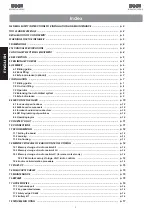
7
BLOCCA / LOCK
BLOQUE / VERRIEGEL
BLOQUEAR / VERGRE
BLOCCA / LOCK
BLOQUE / VERRIEGELT
BLOQUEAR / VERGRENDEL
SBLOCCA / UNLOCK
DEBLOQUE / ENTRIEGELT
DESBLOQUEAR / ONTGRENDEL
SBLOCCA / UNLOCK
DEBLOQUE / ENTRIEGELT
DESBLOQUEAR / ONTGRENDEL
1
1
2
BY-PASS
-
+
-
+
ENGLISH
To set the hydraulic system controlling transmitted power,
turn the two by-pass screws (fig.10).
The red screw controls closing movement torque.
The green screw controls opening movement torque.
To increase torque, turn the screws clockwise.
To reduce torque, turn the screws anti-clockwise.
The point where the automated system begins to make
the slow-down movement can be modified, by moving the
magnetic cylinder inside the seat located on the two arms
of the rocker in the motion unit (fig.11 - ref.2).
Adjust the position of the beam to maximum closing and
opening positions, using the travel limit mechanical stops
as shown in fig.11.ref.1.
- Fit the standard triangular key (Fig.13) in the lock and turn
it
anti-clockwise
through 1 turn.
- Open and close the barrier manually.
To prevent an involuntary impulse from activating the barrier
during the manoeuvre, before restoring normal operation,
switch off power to the system, and turn the triangular key
clockwise
until it stops, and then remove it
.
fig. 13
If the barrier has to be moved manually due to a power cut
or fault of the automated system, use the release device
as follows.
After installation, apply the danger warning sticker on the top
of the upright (Fig. 12).
Check operating efficiency of the automated system and all
accessories connected to it.
Hand the “User’s Manual” to the Client, explain correct
operation and use of the barrier, and indicate the potentially
dangerous areas of the automated system.
fig. 11
6.2 ADJUSTING THE MECHANICAL TRAVEL LIMITS
6.3 ADJUSTING THE MAGNETIC TRAVEL LIMITS
6.4 AUTOMATED SYSTEM TEST
7 MANUAL MODE OPERATION
8 RESTORING NORMAL OPERATION MODE
6 START-UP
fig.10
6.1 ADJUSTING THE TRANSMITTED TORQUE
fig.12
Summary of Contents for 615
Page 1: ...615 615...





























